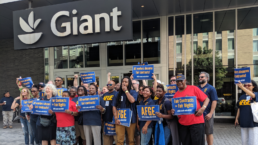Faye Guenther’s multiyear plan to revolutionize the grocery workers union.
by Hamilton Nolan, In These Times
On February 6, 1919, 25,000 Seattle workers from more than 100 different unions walked out in support of 35,000 striking shipyard workers. It was global news. The city was momentarily paralyzed by the most comprehensive display of labor power that post-WWI America had seen.
On the wall of an exhibit about the strike at the Seattle Museum of History and Industry, a small label channels the thinking of the strikers: “Where will this lead? To revolution? Power for workers? The truth is: Nobody knows where!”

A century later, the electrifying heart of Washington’s labor movement can be found in a three-story office building, next to a chiropractor and a Mexican restaurant, in the town of Des Moines, which lies along the bay about 15 miles south of downtown Seattle. There, in the lobby, “educate, agitate, organize” is spelled out in neon blue cursive on the wall. A novelty claw machine holds little plastic bubbles containing bright yellow union T-shirts and beanies. This is the headquarters of United Food and Commercial Workers International Union (UFCW) 3000.
Recent Posts
The “President Of Peace” Prepares For War
December 23, 2025
Take Action Now The Donroe Doctrine Hits HomeBy William D. Hartung, Tom Dispatch Earlier this month, the Trump administration released its new…
“Who Are They Protecting?”: Rep. Ro Khanna Urges Contempt Charges Over AG Bondi’s Epstein Redactions
December 22, 2025
Take Action Now “The House can act unilaterally on contempt, and this will be introduced by Thomas Massie. What the resolution will say is that…
Dems Demand Answers as Trump Photo Disappears From DOJ Online Epstein Files
December 21, 2025
Take Action Now “What else is being covered up?”By Brett Wilkins, Common Dreams Congressional Democrats on Saturday pressed US Attorney General…
Elon Musk Is Vowing Utopia Driven by AI and Robotics. Bernie Sanders Has a Few Questions
December 20, 2025
Take Action Now “I look forward to hearing about how you and your other oligarch friends are going to provide working people with a magnificent life…




